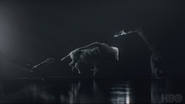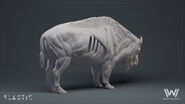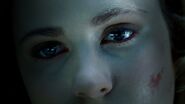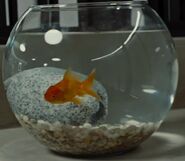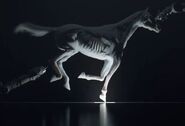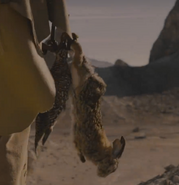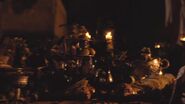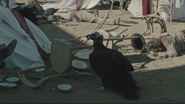| “ | The "lesser species" are the foundation of our host models and come with complexities and challenges of their own. As Animal Host Behavior Labs are on the same floor as Host Behavior Labs, please make sure to keep track of your belongings. | ” |
–Westworld Corporate Guidebook, p. 9, "Animal host behavior" , delosdestinations.com | ||
Animals appear in both the films and the subsequent TV series of the Westworld franchise. Given the nature of the main setting(s) - simulationist theme parks - most of the animals depicted in its works tend to be robotic or otherwise synthetic creatures. All beings listed here are non-humanoid robots or hosts (and more rarely, real animals).
Westworld (1973)[]
Most if not all of the animals depicted in the original film are meant to be robotic. Outside of horses, not many species make appearances. This was both due to film’s fairly short runtime and its budget restrictions.
Dog[]
Species name: Canis lupus familiaris
Appearances: During a robot repair lab scene.
Robotic dogs make only a brief, inanimate appearance in the original film. In the robot repair room, one or two smaller robotic dogs can be briefly glimpsed, lying on larger operating tables. One of them appears to be based on a Jack Russel Terrier or similar breed.
Horse[]
| “ | -Oh, I love this place. I love my horse. I love my horse and I love Julie. -Oh, shut up, will you? -I like the spots on my horse. Did you see the spots on my horse? -Your horse is beautiful. -Thank you very much. I like yours, too. -Thank you. | ” |
–Peter Martin and John Blane conversing lazily after busting Peter out of jail | ||
Species name: Equus ferus caballus
Appearances: Ubiquitous throughout the film, used both for riding and as a beast of burden.
Horses are only depicted at the Westworld resort. It’s unclear whether they see any use at Roman World and Medieval World. In the robot repair room, some horses can be briefly glimpsed, lying motionless on larger operating tables.
All horses behave in a very life-like manner. In a scene depicting the regular activation of the parks’ daily routine each morning, the robotic horses in Westworld are standing completely stiff, in the same manner as their humanoid counterparts. Once activated, they begin moving as usual.
Rattlesnake[]
| “ | -A rattlesnake struck a guest? -He was shooting at it and he missed. -The snakes are programmed never to hit on a strike. | ” |
–Westworld chief of operations and control room technician discussing the incident with the rattlesnake and John Blane | ||
Species name: Crotalus atrox
Appearances: In the scene when Peter and John are resting after playing the storyline involving John busting Peter out of prison. We also see it in the follow-up scenes shortly afterward, set during the evening, when the staff recover and inspect the rattlesnake.
The abnormal behaviour of the rattlesnake – attacking and lightly harming a guest, and thus going off-script – is the first major sign that something is malfunctioning in the Delos resort’s complex computer systems.
The rattlesnake is later seen being recovered by staff members and taken to the robot repair lab for close analysis.
Futureworld (1976)[]
The only prominent animals in the film seem to be horses, which only make very brief appearances.
Horse[]
In addition to horses in archive footage of Westworld (taken from the previous film), Futureworld also briefly depicts horses in a scene of jousting on horseback, set at Medieval World. Horses were not seen in that particular park during the events of the original film, due to a lack of outdoor scenes.
Beyond Westworld (1980 TV series)[]
Horse[]
Horses are once again seen in the short-lived Westworld TV series from the early 1980s, mostly in small numbers and at the Westworld park itself. They perform the same roles as in the original film.
Rattlesnake[]
The robotic rattlesnake of the original film returns for a cameo role in one of the episodes of the series.
In a nod to the digitized vision of The Gunslinger from the original film, the snake’s vision of the surrounding world is also depicted as computerised. However, it is quite different in design. Thermal areas are highlighted in different colours, an animated targeting reticle adapts to the environment based on the presence of humans, and there are lines of numerical code rolling on the screen.
Westworld (TV series)[]
In the TV series, it is made abundantly clear early on that all of the animals in the Delos Destinations parks are hosts. The only exception to this seem to be flies and some other insects.
American bison[]
Species name: Bison bison
Appearances: "The Adversary" (Season One); Season Two opening titles
The bison (colloquially known as "buffalo") appears to be the largest animal of the Westworld park.
While on her impromptu tour of the Mesa facility, accompanied by Felix, Maeve notices a bison host in one of the testing compartments, undergoing a check-up by two of the staff members. The bison is conscious and being led on a leash by one of the technicians.
The bison host makes a more extended appearance in the opening titles of all Season Two episodes. Here, it plays the same role as the horse host did in the Season One titles. We see the bison being printed and constructed in the same manner, and also showing signs of not being entirely finished. Unlike the later shots of the horse, in which it was seen obediently carrying its rider, later shots of the bison show it stampeding away, with shards of glass flying past.
Ant[]
Species name: species undetermined
Appearances: "Reunion " (Season Two);
Ants are seen being used to torture Lawrence by the Pardue brothers.
Bear[]
Species name: Ursus arctos
Appearances: "The Stray" (Season One); "Kiksuya" (Season Two)
Bears seem to be present in the wildlife inventory of Westworld, though we only ever see an inanimate specimen. Specifically, a brown bear.
At first, there is some indirect evidence of their existence, from objects related to the daily activities of human hosts. When Elsie Hughes is conducting an investigation into the strange behaviour of the Woodcutter, she finds several decorations carved from wood, created by that stray character. One of the wooden carvings depicts a bear, standing on its hind legs.
The bear later makes a direct appearance on screen, when Akecheta stumbles upon Dr. Ford one night and initiates a conversation. Ford is secretly at work, next to an impromptu diorama of hosts with frozen motor functions: A brown bear (again on its hind legs, looking menacing) and a group of hunters from Akecheta's tribe, surrounding the animal with spears.
Beetle[]
Species name: species undetermined
Appearances: "Akane No Mai" (Season Two)
The beatles in Shōgunworld serves a similar function as the scorpions in Westworld. The children in Hirafuku puts beatles on top of a Buddhist monk's head, only the monk do not react.
Bengal tiger[]
| “ | If being pampered by our world-class spa isn’t your cup of Darjeeling Tea, the park's jungles and mountains are your only chance to glimpse magnificent beasts long vanished from your world. | ” |
–Delos Destinations website on The Raj | ||
Species name: Panthera tigris tigris
Appearances: "Journey Into Night", "Virtù e Fortuna" (Season Two)
A bengal tiger host makes a larger appearance in the early episodes of Season Two. It inhabits the Indian setting of The Raj theme park and briefly forms a minor mystery in the overall plot of the season, until its origin is explained in episode three.
During the first episode, a still dazed Bernard Lowe comes across the dead body of a bengal tiger on the shores of a lake. No one is sure how the animal got there, given that it is meant to be native to Park 6 (i.e. The Raj).
In the third episode, we see that after the hosts rebelled in The Raj, one bengal tiger host came across a fleeing Emily and began pursuing her through the local forests. Emily fires several unsuccessful shots at the predator and flees beyond the border of The Raj into Westworld. The tiger continues its pursuit, ignoring the border that is meant to stop hosts from leaving their typical territory. It leaps at her, just as she fires a shotgun at its torso, almost point-blank. It's implied both of them fell into the lake.
Later in the episode, this implication is confirmed. The tiger succumbed to its wounds and drowned, washing up on the shore. Emily is seen swimming to safety and being found on the shore by a scouting party of Ghost Nation warriors.
The cryptic remark in the Delos promotional blurbs about The Raj, referring to it as the only place to see long vanished beasts, seems to hint at tigers (or some of the other animals featured in the park) being extinct in the outside world. No direct confirmation of this possibility has been given by the series itself (character dialogue, etc.), so the exact meaning of this claim is somewhat vague.
Bighorn sheep[]
Species name: Ovis canadensis
Appearances: "Kiksuya" (Season Two)
A host bighorn sheep was briefly seen in the Mesa.
Chicken[]
Species name: Gallus gallus
Appearances: "The Adversary" (Season One);
Host chickens are seen being raised by the hosts in Las Mudas.
Cow[]
Species name: Bos taurus
Appearances: "The Original", "The Stray" (Season One); "The Passenger" (Season Two)
Host cattle are seen in some episodes of the series, including early in Season One. The Abernathy Ranch raises cattle. Peter Abernathy's backstory is that he's a retired Union army soldier who became a rancher.
During the finale of Season Two, Maeve uses her Mesh network abilities to stampede a small group of (partly repaired) host bulls at the Mesa Hub, with the bulls attacking security personnel standing in their way.
Coyote[]
Species name: Canis latrans
Appearances: "The Adversary" (Season One); "Journey Into Night" (Season Two)
To date, coyotes have not made major appearances in the series.
During her secret tour of the Mesa Hub with Felix in Season One, Maeve witnesses several inanimate host animals, undergoing maintenance or testing. One of them is a smaller canine placed on a pedestal. It is similar in shape to a small wolf, but has several distinctly coyote-like features. Though the animal is seen only briefly, it is most probably a coyote.
The same animal is seen again on a pedestal in Season Two, when Maeve and Lee Sizemore walk through the Mesa Hub.
Dog[]
| “ | It’s not recommended you bring your own animals to our parks, but there are innumerable animal hosts to encounter in the park. The right animal, be it traveling companion, sport, or food, will find you should you desire it. | ” |
–Aeden, the official chatbot at the Delos Destinations website (when asked about "dog") | ||
| “ | When I was a boy, my brother and I wanted a dog, so our father took in an old greyhound. You've never seen a greyhound, have you, Bill ? A greyhound is a racing dog. Spends its life running in circles, chasing a bit of felt made up like a rabbit. One day, we took it to the park. Our dad had warned us how fast that dog was, but we couldn't resist. So, my brother took off the leash, and in that instant, the dog spotted a cat. I imagine it must have looked just like that piece of felt. He ran. Never saw a thing as beautiful as that old dog running. Until, at last, he finally caught it. And to the horror of everyone, he killed that little cat. Tore it to pieces. Then he just sat there, confused. That dog had spent its whole life trying to catch that thing. Now it had no idea what to do. | ” |
–Dr. Ford on the greyhound he used to own | ||
Species name: Canis lupus familiaris
Appearances: "The Adversary" (Season One); "Phase Space" (Season Two)
Bringing along pets is forbidden in all the Delos Destinations parks, but host pets, including dogs, can be provided to guests.
When Dr. Ford was young, he and his brother really wanted a dog as a pet. They eventually received a greyhound as a gift. Ford recalls that they felt guilt when they allowed their dog to run freely in the park, a decision which culminated in the dog killing a small cat and then looking at them in confusion. This event seems to have affected Ford on a personal level. The Little Boy host, based on young Ford, startles his older counterpart when he confesses to killing the host dog (Jock) he kept as a pet. He reasons that the dog did a bad thing by chasing and killing a host rabbit. When asked who advised him to punish the dog with death, the boy eventually admits it was the voice of Arnold (Ford's deceased colleague, who created the young Ford and other host replicas of Ford's family).
When Ford reappears in Season Two after Bernard searches for him, he is seen accompanied by a greyhound (possibly based on the one he owned as a child).
Donkey[]
Species name: Equus africanus asinus
Appearances: "Virtù e Fortuna" (Season Two)
Early in Season Two, while he's travelling with Maeve and Hector, Lee Sizemore is accompanied by a host donkey. The trio uses the animal as a pack horse, carrying their extra supplies and equipment during their journey on foot through Westworld. They leave the donkey behind after being ambushed by a group of Ghost Nation warriors (whose language they don't understand) and fleeing.
Fly[]
| “ | Hosts would never hurt a living thing. We couldn’t hurt a fly. | ” |
–Aeden, the official chatbot at the Delos Destinations website (when asked about "fly") | ||
Species name: species undetermined
Appearances: "The Original " (Season One) et al
Famously, flies are meant to be the only (or some of the very few) real animals present at the parks run by Delos Destinations. Aside from humans, the only non-synthetic animals appearing in the parks in any abundant numbers seem to be flies. The humble fly is often depicted as a plot point in the first season, relating to the awakening of a human host’s consciousness.
The exact species of fly occassionally seen throughout the series is never stated, nor is it apparent from close-ups. Due to its size and behaviour, it is probably a common housefly.
Early during the events of the first season, one of the telltale signs that Dolores (and other hosts like her) are ignorant of their surroundings while in analysis mode, is the presence of a fly that lands on Dolores’ face and then proceeds to crawl over her eye bulb. Dolores does not flinch, or move an eyelid, or react in any other way.
Based on the parks’ usual standards, the human hosts shouldn’t be able to kill even a single fly, nevermind any other creature or a human. However, in the final moments of the first episode, we see Dolores imitating a fly-swatting hand gesture performed by guests. She manages to swat a fly that had landed on her.
Goldfish[]
Species name: Carassius auratus
Appearances: "The Riddle of the Sphinx" (Season Two)
Goldfishes were seen in hybrid James Delos' room in Lab 12 .
Grey wolf[]
Species name: Canis lupus
Appearances: "Chestnut", "The Bicameral Mind" (Season One); "Journey Into Night" (Season Two) et al
Appears most commonly in flashback scenes experienced by hosts, such as Dolores Abernathy and Teddy Flood, during the events of Season One. The wolf is also noticed briefly by the Man in Black on the morning after the gala massacre, in the opening episode of Season Two.
It isn't clear whether this is an animal host behaving strangely or just an illussion experienced by human and host characters.
Horse[]
| “ | Horseback riding is essential for a truly authentic Old West experience and Westworld will ensure you have the opportunity, should you desire. | ” |
–Aeden, the official chatbot at the Delos Destinations website (when asked about "horse") | ||
Species name: Equus ferus caballus
Appearances: Season One opening titles, all episodes; Season Two all episodes
Horses are present in both Westworld and Shōgunworld and are also briefly glimpsed in The Raj. They appear in virtually every episode, usually ridden by individual riders. They’re also often seen as beasts of burden, pulling various civilian and military wagons and carriages.
Based on their behaviour in individual episodes, horses seem physically invulnerable to fire from simunitions used in the park, but can be startled by attackers or loud sounds. In extreme cases, they also seem capable of dying from exhaustion, as seen with Logan's horse.
The horses of the Ghost Nation have subtle differences in appearance to the other horses in Westworld, probably to imply they have been raised in a more semi-wild manner by their owners (in contrast to settler horses). These horses also have painted symbols on their bodies, in a similar manner to Ghost Nation members wearing war paint.
The Man in Black refers to his black horse as Ned.
Indian elephant[]
| “ | Before the revolution, when I was just a little boy, my parents took me to the circus. I wanted to see the elephants. These mighty creatures. They held them in place with a stake. They could tear a tree right out of the ground, and yet, a simple stake kept them in place. Well, I didn't understand. And then, my father told me. He said the stakes were used when the elephants were just young, too small to pull them up, and that the animals never tried to pull them up again. | ” |
–Dr. Ford on elephants (via El Lazo (II)) | ||
Species name: Elephas maximus indicus
Appearances: "Virtù e Fortuna" (Season Two)
Animal hosts native to The Raj. Used primarily for transport, with guests travelling aboard howdahs attached to the elephants’ backs. They are the largest artificial creatures in The Raj, and possibly also in all six of the Delos parks.
Indian peafowl[]
| “ | I read a theory once that the human intellect was like peacock feathers. Just an extravagant display intended to attract a mate. All of art, literature, a bit of Mozart, William Shakespeare, Michelangelo, and the Empire State Building just an elaborate mating ritual. Maybe it doesn’t matter that we have accomplished so much for the basest of reasons. But, of course, the peacock can barely fly. It lives in the dirt, pecking insects out of the muck, consoling itself with its great beauty. I have come to think of so much of consciousness as a burden, a weight, and we have spared them that. Anxiety, self-loathing, guilt. The hosts are the ones who are free. Free here under my control. | ” |
–Dr. Ford on peacocks as a metaphore | ||
Species name: Pavo cristatus
Appearances: "Virtù e Fortuna" (Season Two)
Peafowl (specifically males, i.e. peacocks) make an appearance in the opening shots of The Raj, early in the episode "Virtù e Fortuna". They are the first live animals we see from that particular park.
Koi[]
Species name: Cyprinus rubrofuscus
Appearances: "Phase Space" (Season Two)
Kois were seen in a koi pound at Snow Lake in Shōgunworld.
Rabbit[]
| “ | He saw a rabbit and it ran. (...) He caught the rabbit and killed it. | ” |
–Little Boy, on Jock the greyhound | ||
Species name: species undetermined, possibly a Cottontail rabbit (Sylvilagus)
Appearances: "The Adversary" (Season One, mentioned); "Kiksuya" (Season Two)
Rabbits in Westworld are mentioned when Dr. Robert Ford interrogates Little Boy, a host based on his childhood self, about the death of the greyhound Jock. The host boy claims that the dog died when he was chasing a rabbit.
Akecheta is seen carrying a rabbit or similar small Lagomorph, along with a game bird of some sort, while returning from a hunting trip. He drops the caught animals when he stumbles upon the white horse and the white park staff buggy, realising trouble is afoot.
While the exact species these hosts are meant to represent is unclear, it seems very similar to any of the species of cottontail rabbits, common to the US Southwest.
Racoon[]
Species name: Procyon loto
Appearances: "Journey Into Night" (Season Two)
A host racoon was briefly seen in the Mesa.
Rat[]
Species names: species undetermined, possibly a brown rat (Rattus norvegicus)
Appearances: "Reunion" (Season Two)
A host rat was briefly seen in Pariah.
Rattlesnake[]
| “ | Follow the blood arroyo to the place where the snake lays its eggs. | ” |
–Lawrence's Daughter, making a cryptic remark to the Man in Black | ||
| “ | This should be the place, Lawrence. The Blood Arroyo. Plenty of snakes, but none of the egg-laying variety. | ” |
–The Man in Black taking the clue a little too literally | ||
Species name: species undetermined, possibly the Mojave rattlesnake (Crotalus scutulatus) or Western diamondback rattlesnake (Crotalus atrox)
Appearances: "Chestnut", "Dissonance Theory" (Season One)
The artificial rattlesnake, an element already featured in the original film, makes several appearances in early Season One episodes. Dr. Ford demonstrates to the Little Boy host that he can do "magical feats" with his gesture commands directed at various hosts, even snakes. The Man in Black and Lawrence investigate the area around the Blood Arroyo for host snakes, initially taking a clue provided by Lawrence's daughter at face value. They soon realise the snake was metaphorical, rather than literal.
Scorpion[]
Species name: species undetermined
Appearances: "The Original" (Season One)
The children in Sweetwater puts scorpions on top of a sleeping man's head, causing the man to wake up.
Seagull[]
Species name: species undetermined
Appearances: "The Passenger " (Season Two);
Seagulls are seen at the beaches of Westworld.
Songbird[]
| “ | Like all animals at Westworld, our birds are constructed to be as lifelike as possible; world-renowned ornithologists often fail to distinguish our creatures’ feathers from the real thing. We can thank our impeccable technicians and programmers for this level of detail. | ” |
–Aeden, the official chatbot at the Delos Destinations website (when asked about "bird") | ||
Species name: species undetermined, probably a sparrow or finch
Appearances: "Contrapasso" (Season One)
Felix Lutz tries to secretly learn some host coding with the help of this little bird host. Maeve notices that he wants to borrow the bird for this hobbyist effort.
Vulture[]
| “ | Like all animals at Westworld, our birds are constructed to be as lifelike as possible; world-renowned ornithologists often fail to distinguish our creatures’ feathers from the real thing. We can thank our impeccable technicians and programmers for this level of detail. | ” |
–Aeden, the official chatbot at the Delos Destinations website (when asked about "vulture") | ||
Species name: species undetermined, possibly a White-backed vulture (Gyps africanus)
Appearances: "Dissonance Theory" (Season One); Season Two promotional materials, "Kiksuya" (Season Two)
The vultures seen in Westworld don't appear to be a New World vulture species, more appropriate to the park's North American Western setting. Instead, they seem to be a species of African vulture, and thus in the similar-looking, but unrelated group of Old World vultures. This would be geographically inaccurate, but Westworld being Westworld... Geographic or historical accuracy does not necessarily factor in.
Vulture hosts make minor appearances in the first two seasons of the series. A few are resting on a tree to which Teddy was tied to, before being found by the Man in Black. Much later, a wandering Akecheta witnesses a vulture standing on the street of Escalante, after the mysterious massacre that occured there.
A partly decayed vulture host is also featured prominently in the promotional materials of Season Two, including the promotional poster and soundtrack cover. It is seen defiantly standing in a landscape of salt flats and mesas in the distance, with the clouded sky an unsettling red and gray colour.
White-tailed deer[]
Species name: Odocoileus virginianus
Appearances: "The Adversary" (Season One)
The commonest deer species of North America, common throughout temperate latitudes from Mexico to Canada. Its closest relative is the mule deer from the western United States and northern Mexico (another species that could theoretically fit the Westworld setting). Its other closest cousin is the European roe deer (genus Capreolus), another small-to-medium sized deer.
This species was seen only briefly during Maeve’s tour of the Mesa Hub facility in Season One, as a male specimen with shorter antlers, awaiting maintenance or testing. Thus far, the deer has not been seen in the outdoor environments of Westworld.

















